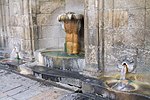Redondela railway station
Buildings and structures in the Province of PontevedraPages with no open date in Infobox stationRailway stations in Galicia (Spain)Spanish railway station stubs

Redondela railway station is the main railway station of Redondela in Galicia, Spain. It mainly serves regional and long-distance traffic across different areas in Galicia and northern Spain in general, whereas high-speed traffic is served by the nearby Redondela AV railway station, in the outskirts of town.
Excerpt from the Wikipedia article Redondela railway station (License: CC BY-SA 3.0, Authors, Images).Redondela railway station
Rúa de Eulogio Gómez Franqueira, Ourense San Rosendo
Geographical coordinates (GPS) Address Nearby Places Show on map
Geographical coordinates (GPS)
| Latitude | Longitude |
|---|---|
| N 42.3504 ° | E -7.8728 ° |
Address
Estación Ferrocarril Empalme
Rúa de Eulogio Gómez Franqueira 5
32003 Ourense, San Rosendo
Galicia, Spain
Open on Google Maps







